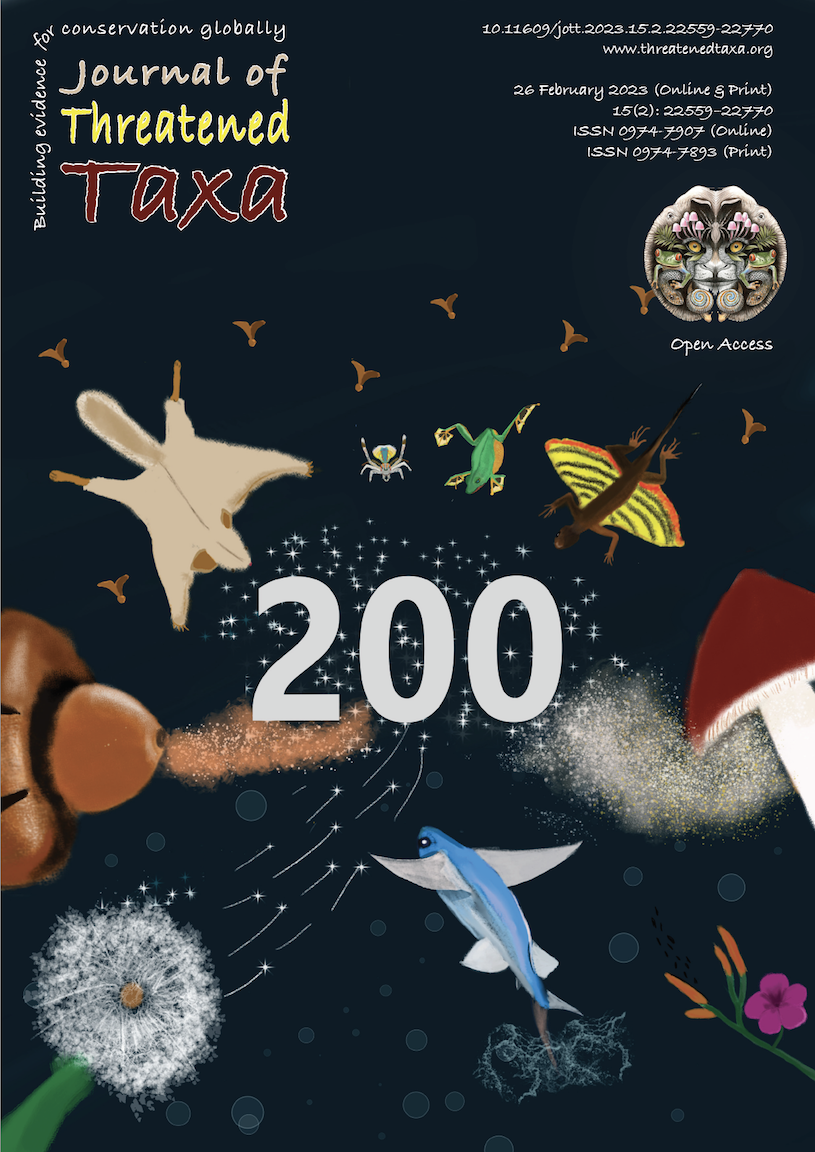First record of the Great Seahorse Hippocampus kelloggi Jordan & Snyder, 1901 (Actinopterygii: Syngnathiformes: Syngnathidae) from the northwestern coast of Bay of Bengal
DOI:
https://doi.org/10.11609/jott.8171.15.2.22737-22740Keywords:
Conservation, Kellog’s Seahorse, migration, monitoring, VulnerableAbstract
This study reports the first occurrence of the Great Seahorse Hippocampus kelloggi from the state of Odisha in the eastern coast (Bay of Bengal) of India. The seahorse was captured in a ring net during daily fishing activities. The sample was collected from the Ariyapalli fish landing center and identification was carried out based on the morphometric features of the specimen and the seahorse identification guide. The total length of the juvenile seahorse was 12.5 cm (with a tail length of 6.6 cm (52.8%), trunk length of 3.4 cm (27.2%) and head length of 2.5 cm (20%)). The length of the snout was 1 cm. There were 38 tail rings followed by 11 rings on the trunk of the animal. Both eye and cheek spines were present. Northward migration (~1,300 km) of this species can be a response of extensive fishing activities around the southern coast of India. This calls for increased monitoring of the coast coastal ecosystems of India on the east coast for better conservation and management of the remaining seahorse populations.
References
Balasubramanian, R. & A. Murugan (2017). Length-weight relationship of the Great Seahorse, Hippocampus kelloggi (Jordan and Snyder 1902), inhabiting Coromandel Coast, southeast coast of India. Indian Journal of Geo-Marine Sciences 46:1193–1197
Foster, S.J. & A.C.J. Vincent (2004). Life history and ecology of seahorses: Implications for conservation and management. Journal of Fish Biology 65:1–61. https://doi.org/10.1111/j.0022-1112.2004.00429.x
IUCN (2022). Most threatened species — IUCN Seahorse, Pipefish & Seadragon (www.iucn-seahorse.org).
Jeyabaskaran, R., J. Jayasankar & T.V. Ambrose (2018). Conservation of seagrass beds with special reference to associated species and fishery resources. Journal of the Marine Biological Association of India 60: 62–70. https://doi.org/10.6024/jmbai.2018.60.1.2038-10
Kavungal, V. & R. Saravanan (2015). Participatory management for conservation of seahorses in the Gulf of Mannar, South East coast of India BOBLME-2015-Ecology-58. Boblme. https://doi.org/10.13140/RG.2.1.2864.6001
Li, C., M. Olave & Y. Hou, G. Qin, R.F. Schneider, Z. Gao, X. Tu, X. Wang, F. Qi, A. Nater, A.F. Kautt, S. Wan, Y. Zhang, Y. Liu, H. Zhang, B. Zhang, H. Zhang, M. Qu, S. Liu, Z. Chen, J. Zhong, H. Zhang, L. Meng, K. Wang, J. Yin, L. Huang, B. Venkatesh, A. Meyer, X. Lu & Q. Lin (2021). Genome sequences reveal global dispersal routes and suggest convergent genetic adaptations in seahorse evolution. Nature Communications 12: 1094. https://doi.org/10.1038/s41467-021-21379-x
Lourie, S.A., S.J. Foster, E.W.T. Cooper & A.C.J. Vincent (2004). A Guide to the Identification of Seahorses. University of British Columbia and World Wildlife Fund, Washington D.C.
Luzzatto, D.C., M.L. Estalles, J.M.D. de Astarloa (2013). Rafting seahorses: The presence of juvenile Hippocampus patagonicus in floating debris. Journal of Fish Biology 83: 677–681. https://doi.org/10.1111/jfb.12196
Mahapatro, D., R.K. Mishra & S. Panda (2017). Range extension of a vulnerable Sea horse Hippocampus fuscus (Actinopterygii: Syngnathidae) on the north-eastern Bay of Bengal coast. Marine Biodiversity Records 10: 6. https://doi.org/10.1186/s41200-017-0108-z
Mishra, A.K. & D. Apte (2021) The current status of Halophila beccarii: An ecologically significant, yet vulnerable seagrass of India. Ocean Coast Manag 200: 105484. https://doi.org/10.1016/j.ocecoaman.2020.105484
Mishra, A.K. & S.H. Farooq (2022) Lack of ecological data hinders management of ecologically important saltmarsh ecosystems: A case study of saltmarsh plant Porterasia coarctata (Roxb.). Journal of Environmental Management 321: 115957. https://doi.org/10.1016/j.jenvman.2022.115957
Salin, K.R., T.M. Yohannan & C.M. Nair (2005). Fisheries and trade of seahorses, Hippocampus spp., in southern India. Fisheries Managemant and Ecology 12: 269–273. https://doi.org/10.1111/j.1365-2400.2005.00450.x
Sanaye, S.V., R. Khandeparker, A.S. Rayadurga, M.S. Shivaramu, H. Kankonkar, J. Narvekar & M. Gauthankar (2020). Morphological and molecular evidence for first records and range extension of the Japanese Seahorse, Hippocampus mohnikei (Bleeker 1853) in a bay-estuarine system of Goa, central west coast of India. PLoS One 15:1–22. https://doi.org/10.1371/journal.pone.0220420
Sreepada, R.A., U.M. Desai & S. Naik (2002). The plight of Indian sea horses: need for conservation and management. Current Science 82: 377–378.
Teske PR, Hamilton H, Palsbøll, C.K. Choo, H. Gabr, S.A. Lourie, M. Santos, A. Sreepada, M.I. Cherry & C.A. Matthee (2005). Molecular evidence for long-distance colonization in an Indo-Pacific seahorse lineage. Marine Ecology Progress Series 286: 249–260.
Vaidyanathan, T. & A.C.J. Vincent (2021). State of Seahorse Fisheries in India, Nearly Two Decades after they were Banned. Springer, Netherlands.
Zhang, X. & A.C.J. Vincent (2018). Predicting distributions, habitat preferences and associated conservation implications for a genus of rare fishes, seahorses (Hippocampus spp.). Diversity and Distributions 24:1005–1017. https://doi.org/10.1111/ddi.12741
Published
Versions
- 26-02-2023 (2)
- 26-02-2023 (1)
Issue
Section
License
Copyright (c) 2023 Anil Kumar Behera, Biswajit Mahari, Amrit Kumar Mishra

This work is licensed under a Creative Commons Attribution 4.0 International License.
Authors own the copyright to the articles published in JoTT. This is indicated explicitly in each publication. The authors grant permission to the publisher Wildlife Information Liaison Development (WILD) Society to publish the article in the Journal of Threatened Taxa. The authors recognize WILD as the original publisher, and to sell hard copies of the Journal and article to any buyer. JoTT is registered under the Creative Commons Attribution 4.0 International License (CC BY), which allows authors to retain copyright ownership. Under this license the authors allow anyone to download, cite, use the data, modify, reprint, copy and distribute provided the authors and source of publication are credited through appropriate citations (e.g., Son et al. (2016). Bats (Mammalia: Chiroptera) of the southeastern Truong Son Mountains, Quang Ngai Province, Vietnam. Journal of Threatened Taxa 8(7): 8953–8969. https://doi.org/10.11609/jott.2785.8.7.8953-8969). Users of the data do not require specific permission from the authors or the publisher.





